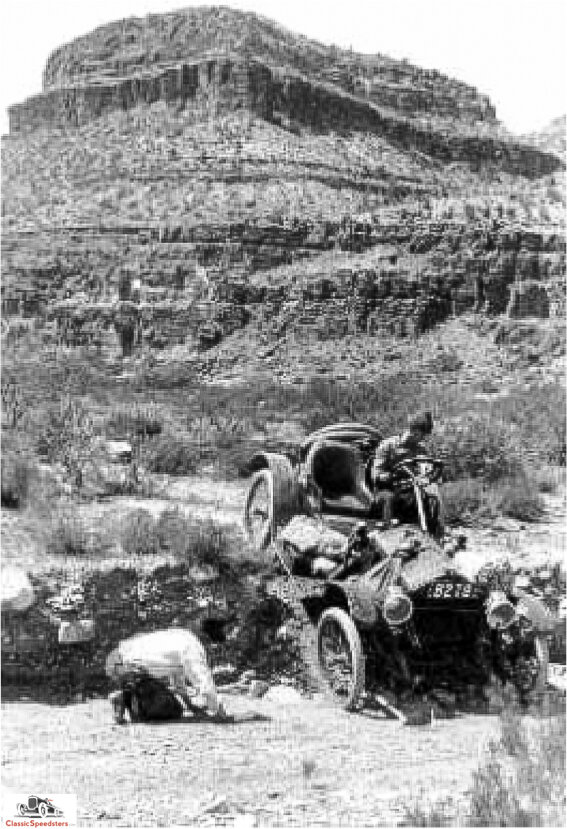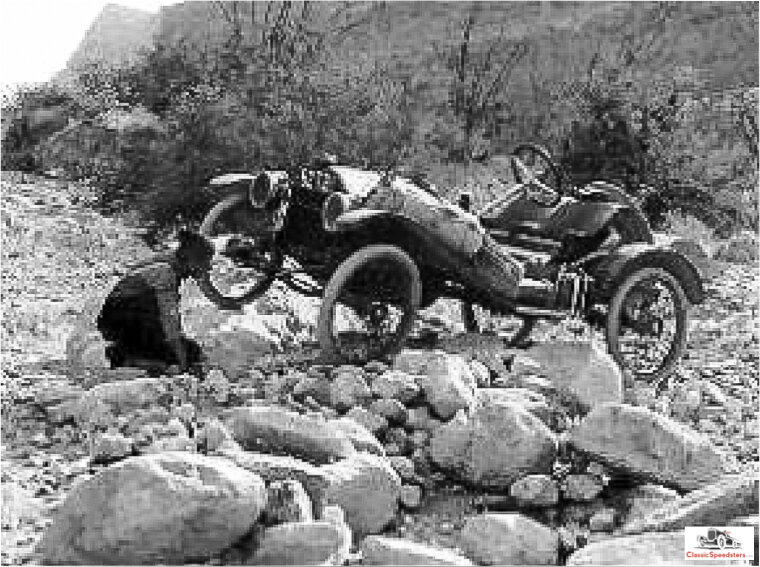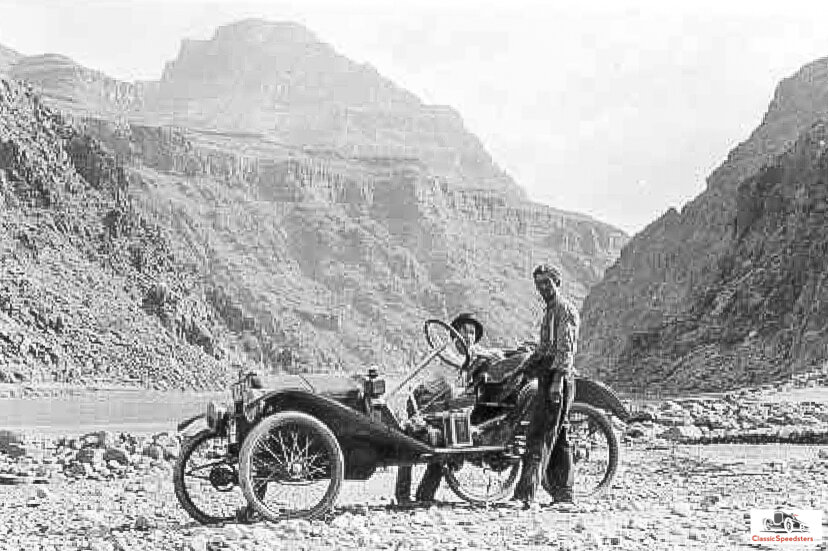Much To Crow About
Charles Metz knew that he had a good thing going when his team of three Metz 22s finished 1-2-3 in the 1913 Glidden Reliability Tour, which began in Minneapolis, Minnesota and ended at Glacier National Park in Montana. Three cars with perfect scores.
1913 Metz Model 22. The Glidden team may have used the all-weather covering for the passenger compartment. Images courtesy Antique Automobile magazine archives
They started dead last on the last day, passed everyone in the field including the pacemaker, and scooted to the finish twenty minutes ahead. Not bad for the lowest cost car in the field. Not bad for a vehicle with a friction plate for a transmission!
What Good Luck, What Bad Luck
Winning the Glidden was probably a stroke of misfortune for Charles Metz for a few reasons:
1. His cars were selling moderately well, and winning the Glidden trophy significantly boosted sales
2. Winning obscured the fact that Metz cars had an outdated propulsion system
3. Charles Metz was brilliant but stubborn, and Glidden success only made him more convinced to stay the course.
So why fix what ain’t broke? This axiom does not often work in the automotive world, especially when considering evolving and competing technology.
The Metz Speedster
Following up such a winning year was going to be a challenge, and so the Metz Company rolled up its sleeves for 1914.
1912 Metz Model 22 Roadster, which did not appreciably change in configuration during its four-year model run.
The 1912 Roadster model had given way to its successor, the 1913 Metz Special. This was no doubt the “standard” Roadster model that served as the prototype for the Glidden.
1913 Metz Special. Cylindrical gas tank. No jump seat. Note the canvas covering for all-weather adventuring. Or maybe just getting supplies on a rainy day!
The weather-proofing “tent” around the passenger compartment was customary fare for cars performing rough and rugged duty in the outback. However, since the United States had yet to overcome the political resistance to paved roads outside of cities, “outback” would pretty much describe most of the United States in 1914. The “Good Roads Movement” battled against the political forces for years to win this fight over paved roads. The Railroad Lobby knew that the rise of paved roads would pretty much cause their decline.. Which it did!
Rain aprons protected folks in open cars until the manufacturers were able to develop durable hard tops made of wood, steel, cloth, and glass that would not shake themselves to pieces on the rough roads of early twentieth-century U.S.
Like the 1913 Metz Special, the 1914 Metz Speedster was no great departure from the successful Metz 22 of 1912. In true speedster form, it served as a stripper model, having fewer features and adopting a modestly more sporty look with fewer baubles and headlights incorporated into the fenders.
1914 Metz Speedster. Note the lack of accessories and no jump seat, but with an oval gas tank, wire wheels, and headlights integrated into the fenders. All came painted in orange with black fenders.
As witnessed in the specs listed in the 1914 Metz Speedster and the standard brochures, the vehicle used a ladder frame of 90” wheelbase and variable track of either 48” or 56” depending on how one mounted the wheels. The four cylinder cast enbloc engine produced 22.5 SAE-rated horse power and connected to the rear wheels using the Metz friction drive system. The Speedster weighed in at 1000 pounds and wore a snazzy orange coat with black fenders. Sharp!
Although considered antiquated by many, the Metz friction drive certainly acquitted itself well, not only in the 1913 Glidden, but also in the following adventure as recounted by O.K. Parker, a young Los Angeles reporter. Parker accompanied mechanic F.L. Wing of the Metz Factory Branch in Los Angeles on what can only be described as one heck of a journey: fourteen hundred miles through the desert, over the Rockies, and down into the depths of the Grand Canyon.
All done in a cutdown-style speedster!
1914 Metz Speedster brochure. Two fans out on a jaunt!
The Metz Speedster’s Big Adventure
The following consists of quotes taken from two accounts written by Parker, one appearing in the December 1914 issue of Motor, and the other filed in the archives of the United States National Park Service.
***********
The two lads set out from Los Angeles to an Arizonan train depot on the Santa Fe railroad line. “The course of the route from Los Angeles to Peach Springs (Arizona)… is through the sand deserts south of Death Valley and across the Colorado River at Needles. That trip alone is a real test of both automobile and man, as it involves torrid stretches of desert waste where water, food, and camping equipment are essential to the safety of the traveler.
“… in addition to the sands of the Colorado Basin, three mountain ranges must be crossed at altitudes from three to five thousand feet.” Anyone who has been on this route knows that it is a treacherous journey unless traveled in a modern fuel-injected and air-conditioned vehicle.
“Once a test like this is successfully passed, the motorist feels that his machine has the stamina to tackle even the dreaded gorge on the way to the bottom of the Grand Canyon.” The erstwhile duo then journeyed to El Tovar Point, where nearby the historic El Tovar Hotel perches on the edge (and overlooks) a portion of the Grand Canyon.
El Tovar Hotel in 1914 as seen from the front entrance and courtyard. Note the shadow on the right indicates the sheer drop of the ledge upon which El Tovar is sited.
El Tovar Hotel in 2020. This is probably the back of the hotel in relation to its 1914 photo. There is a tree-lined road to access the building, but then the rock wall drops off fairly quickly. The 1914 photo shows a large lot in front of the hotel that is not in this photo and the turret is off-center in this second photo.
Wing and Parker then drove past the lodge and to the end of the road. “… we ran the car through the rocks and brush until we found one point of cliff projecting over the canyon rim 3,180 feet above the first plateau, and 5,528 feet above the bottom of the canyon.
“There was a sheer drop at that one spot making a clean drop of over 2,000 feet,…”
1914 Metz Speedster at El Tovar Point. The late afternoon shadows show off the details of the car rather well. Note the headlights are not what the catalog featured for the Speedster. The driver’s side wheel is wisely chocked for safety. Wing may not be as nutty as he looks, as his right hand is hooking the lip of the fender for a bit of security. Who’s crazier, the onlooker or the cameraman?
“Mr. Wing stopped the wheels when they were within a foot of the very edge of the cliff.”
1914 Metz Speedster on the edge. Note that all four wheels are now chocked. I’m getting vertigo just looking at this photo!
After taking photos and then camping for the night, the two mapped out their journey to the floor of the canyon and the Colorado River. Before they started their descent, “…we arranged with Mr. Willitts, Superintendent of the Hualapi Indian Reservation, that if we did not return the second night he was to send an Indian and three saddle horses together with a little emergency grub to meet us somewhere in the canyon.” Good idea: a Plan B!
Their trip down the steep canyon walls to the riverbed included “…negotiating deep sand arroyos, steep grades, great boulder filled canyons, mud flats and knee deep rushing torrents…
“In places the grade was 25 to 30 percent, and only the remarkable pulling qualities of the fiber grip transmission enabled us to get over the terrific deposits of debris and boulders that mark the accumulation of ages.” (This is quite an endorsement of the friction drive system, something that many had considered to be antiquated and outmoded)
Descending the mountain to the canyon floor.
“At times, the car forcing its way over those big piles of boulders, became so distorted that the rear wheels would be tilted at an angle of 30 degrees in one direction, while the front wheels were tilted at an angle of 20 or 30 degrees in the opposite direction. A bigger heavier car would never have withstood the strain.
Working around rocks, boulders, and brush. Note the clearance under the running board.
“During this whole distance of seventeen miles from pump house to the river, it was one continuous fight against obstacles, which on an ordinary country road would have immediately been judged impassable.
“After passing these narrow points we… frequently encountered boulders that had become blocked in the bed of the wash, and piled up, presenting an obstacle formidable enough to discourage the stoutest heart - and you would think - to put out or commission the toughest car. But the way our Metz climbed over that stuff was almost unbelievable, now as I think back on it.
Overcoming obstacles. Note the flex in the frame.
“Darkness overtook us when we were still one and one-half miles from the bottom of the Canyon. We camped here for the night, and some night it was! About 10:30 it began to rain, and within a few minutes we were drenched to the skin by one of the severest thunderstorms I have ever seen.
“It seemed as if Nature herself was trying to punish us for attempting to invade her virgin pastures with a modern roadster speed devil.
Finally they reached the canyon floor, explored around a bit, and then moved on. They had achieved their goal!
Reaching the Colorado River at the floor of the Grand Canyon. First time ever!
Luckily for the pair, the Metz chugged along. “The car showed to great advantage on the hills and negotiated them with an ease and sureness that surprised even we two who had become rather inured from witnessing each achievement of the car on the downward trail. … Our experiences stood us in good stead upon the return trip and we made remarkable time.
“Now, instead of being experimenters, so to speak, we were tourists, and I can assure you we keenly enjoyed the exhilarating trip to the top, and it was with no little satisfaction that we looked back from each new height gained with the thought that we were probably the first to make the trip in this way.
“As it turned out, … we made the journey and returned to Los Angeles without so much as breaking one single part or having any mechanical trouble. Never did we use a wrench to tighten a bolt or nut.”
Another great endorsement!
The round trip down to the canyon floor and back up was forty-two miles. “In that comparatively short distance we used twelve gallons of gasoline, only getting three and a half miles per gallon,…”
The Metz typically travelled for 30 miles (on regular roads) per gallon of gas consumed.
The Inequity of Fate
Metz’s reputation rode on the coattails of its Glidden win in 1913, the last year of that event. Sales increased to 4648 units in 1913, followed by another banner year of 6151 in 1914, and then increased sales in 1915 and 1916 (with some help from the new Model 25). This proved that the market existed for a cheap, lightweight car. Even though it was Model T-like in its technical simplicity, the 22 and the 25 were inexpensive and effective. They were what the people wanted, and folks bought them in the thousands.
As recounted in the previous post about this firm, history would not be kind to the Metz Company. Despite introducing a more modern car in the post-war years, the Master Six, gone was the lightweight and cheap Metz 22, as the Master Six weighed twice as much and cost twice to boot. And so its customer base abandoned Metz to shop elsewhere.
The nonpayment of bills owed to Metz by the U.S. government, the postwar depression, and the lack of sales all conspired to kill the Metz Company. And they did.
Waltham National Bank repossessed the company in 1921, dispossessed Charles Metz of his creation, and then kicked him to the curb as thanks for all that he had done in saving Waltham Manufacturing and jobs for the surrounding community.
The Metz logo that would have appeared on the 1914 Speedster.
How many of the skilled craftsmen from Waltham who had worked at Metz during its glory years and then lost their jobs, or had bought Metz cars – this has never been traced nor tallied. Suffice to say that the Waltham, successor to the Metz, lasted one year (1922), the last gasp of auto manufacturing in this proud community.
Yet, despite the unkind whims of Fate, the Metz Speedster had endured its summer trials and made its mark:
First to the bottom of the Grand Canyon - and back!
Young man out for a ride in a Metz Speedster.
In the near future I’m going to send out a short survey to all of my readers about what type of device do you use to read this journal? Also, do you read ebooks, and on what device do you do that?
My reasons are simple. I’d like to create ebooks about classic speedsters and the folks who owned and drove them. There’s a whole world out there of potential speedster enthusiasts who would like to know more about this historical phenomenon, and I’d like to reach them. eBooks are a proven way to do that.
As always, I appreciate your support and comments. Please use the share buttons on the left to share this journal with your tribe. And if you haven’t yet, please subscribe - that box is on the right.
So, stay tuned for my survey, and go self-isolate in your speedster!

















